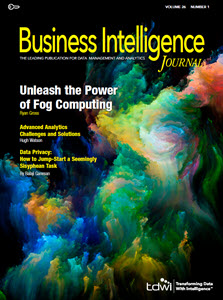
Business Intelligence Journal | Vol 26, No 1
TDWI Member Exclusive
June 15, 2021
Staying on top of tomorrow’s trends while meeting current challenges is a tough balancing act. This issue of the Business Intelligence Journal addresses today’s problems and tomorrow’s new technology.
Senior editor Hugh Watson set out to better understand the daily challenges of advanced analytics (and how to respond to them) by interviewing four consultants, managers, and professionals. They identified the most important and interesting problems. You’re sure to recognize these problems in your own environment and, like Hugh, gain new perspective on the solutions.
Troy Hiltbrand has an eye on supplying the skills needed for our analytics future. As companies shift from department-focused, project-based work to cross-discipline, product-based work, employees will need a host of new skills. What are the skill models managers need to know and how can they alleviate the need to hire a super-star data scientist?
Analytics isn’t just about dealing with more data. Enterprises are facing more data from more sources, which increases the demand for a unified view of their data. As authors Saptarshi Sengupta and Ravi Shankar point out, using data virtualization to solve the “unification problem” has evolved into adoption of logical data fabrics, which incorporate data integration technology, AI and ML, and data catalogs. In this issue they explore the benefits of a data fabric.
Of course you can’t just use any data, as current and future regulations are proving. Unfortunately, keeping data private can seem overwhelming at times. Balaji Ganesan explores key considerations in privacy initiatives (such as scalability and geographic complexities) and offers suggestions for accelerating how you implement a data privacy solution today without short-changing long-term needs.
When it comes to collecting and processing all that data, enterprises are no longer confined to on-premises operations. The move to the cloud has taught us that. Ryan Gross thinks another technology is just as important: fog computing. He expects it to dramatically reduce the cost of operating data platforms while enabling new real-time use cases that don’t work in the cloud-and-back architecture most enterprises use today. Gross describes the challenges (and how to mitigate them) of fog technology and how your organization can accelerate its adoption in the future.
Rob Armstrong, William McKnight, and Steve Williams—our BI experts for this issue—take on a more personal task: offering advice about business and organizational BI and analytics realities—truths they’ve found that stand the test of time. What have they learned and what lessons will their fresh-out-of-college mentees profit from?
We welcome your thoughts about this issue; write me at [email protected]